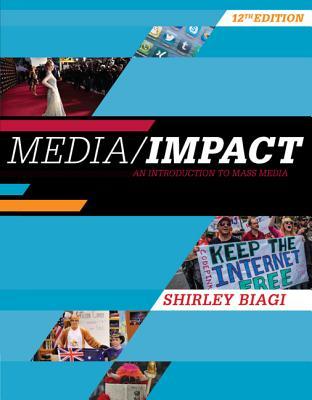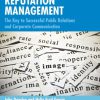(EBOOK PDF)Media Impact An Introduction to Mass Media 12th edition by Shirley Biagi 9781305580985 1305580982 full chapters
$50.00 Original price was: $50.00.$35.00Current price is: $35.00.
Media Impact An Introduction to Mass Media 12th edition by Shirley Biagi – Ebook PDF Instant Download/Delivery: 9781305580985, 1305580982
Full download Media Impact An Introduction to Mass Media 12th edition after payment
Product details:
• ISBN 10:1305580982
• ISBN 13:9781305580985
• Author:Shirley Biagi
Media/Impact: An Introduction to Mass Media
Consistently praised for its engaging writing style, currency, and visual appeal, MEDIA/IMPACT: AN INTRODUCTION TO MASS MEDIA, 12th Edition focuses students on today’s digital mass media industries and support businesses as well as the legal, ethical, social, global, and technological issues that these businesses face every day. The twelfth edition focuses on convergence–how the mass media industries are intersecting to deliver content and how audiences are adapting to the new mass media marketplace. Providing thorough yet balanced coverage, the author grounds her discussion in the business aspects of all the mass media industries, with concise histories of each industry plus an insider’s look at what it’s like to work in each business. The new edition delivers the most up-to-the-minute coverage available of such emerging topics as digital delivery, net neutrality, media industry consolidation, social media, mobile media, and much more.
Media Impact An Introduction to Mass Media 12th Table of contents:
Chapter 1. Mass Media and Everyday Life
Mass Media Are Everywhere You Are
Mass Communication Becomes Wireless
How the Communication Process Works
What Are the Mass Media Industries?
Books
Newspapers
Magazines
Recordings
Radio
Movies
Television
The Internet
Three Key Concepts to Remember
Mass Media Are Profit-Centered Businesses
Convergence Dominates the Media Business
Why Media Properties Converge
Advertisers and Consumers Pay the Bills
Technology Changes Mass Media Delivery and Consumption
Phonetic Writing: The First Information Communications Revolution
Printing: The Second Information Communications Revolution
Computer Technology: The Third Information Communications Revolution
Media Take Advantage of Digital Delivery
One-Way Versus Two-Way Communication
Dumb Versus Smart Communication
How Today’s Communications Network Operates
The Receiver (You, the Subscriber)
The Channel (Cable, Telephone, Satellite and Cellular Companies)
The Sender (Internet Service Providers)
The Message (Content)
Mass Media Both Reflect and Affect Politics, Society and Culture
Why You Should Understand Mass Media and Everyday Life
Reviewing Chapter 1
Key Terms
Critical Questions
Working the Web
Chapter 2. Books—Rearranging the Page
Publishers Nurture Ideas and Try to Make a Profit
How American Book Publishing Grew
Political Pamphlets
Novels and Poetry
Humor
International Copyright Law of 1891
Publishing Houses
Compulsory Education
Cheaper Books Create a Mass Market
Book Clubs
Paperbacks
Grove Press Tests Censorship
Investors Buy Up Publishing Companies
Book Publishing at Work
Books Begin with Authors and Agents
How Do Books Get Published?
The Book Industry Has Three Major Markets
Adult and Juvenile Trade Books
Textbooks
Professional and Scholarly Books
Audiobooks and E-books Multiply the Audience
Audiobooks
Electronic Books
Corporations Demand Higher Profits
Subsidiary and International Rights
Blockbusters
Chain Bookstores and Internet Retailers Compete
Small Presses Seek Specialized Audiences
New Technologies Affect Production and Delivery
Book Publishing Today Is a Competitive, Complex Business
Reviewing Chapter 2
Key Terms
Critical Questions
Working the Web
Chapter 3. Newspapers—Mobilizing Delivery
First Mass Medium to Deliver News
Publishers Fight for an Independent Press
James Franklin’s New England Courant Establishes an Independent Press Tradition
Benjamin Franklin Introduces Competition
Truth Versus Libel: The Zenger Trial
Women’s Early Role as Publishers
Birth of the Partisan Press
The Stamp Act
The Alien and Sedition Laws
Technology Helps Newspapers Reach New Readers
Frontier Journalism
Ethnic and Native American Newspapers
Dissident Voices Create the Early Alternative Press
Newspapers Seek Mass Audiences and Big Profits
Newspapers Dominate the Early 20th Century
Competition Breeds Sensationalism
Yellow Journalism Is Born: Hearst’s Role in the Spanish-American War
Tabloid Journalism: Selling Sex and Violence
Unionization Encourages Professionalism
Television Brings New Competition
Alternative Press Revives Voices of Protest
Newspapers Expand and Contract
Newspapers at Work
Technology Transforms Production
Consolidation Increases Chain Ownership
Newspapers Fight to Retain Readers
National Newspapers Seek a Wider Audience
Internet Editions Open Up New Markets
Today’s Newspaper Audience Is a Moving Target
Reviewing Chapter 3
Key Terms
Critical Questions
Working the Web
Chapter 4. Magazines—Chasing the Audience
Magazines Reflect Trends and Culture
Colonial Magazines Compete with Newspapers
Magazines Travel Beyond Local Boundaries
Publishers Locate New Readers
Women’s Issues
Social Crusades
Fostering the Arts
Political Commentary
Postal Act Helps Magazines Grow
McClure’s Launches Investigative Journalism
The New Yorker and Time Succeed Differently
Harold Ross and The New Yorker
Henry Luce’s Empire: Time
Specialized Magazines Take Over
Companies Consolidate Ownership and Define Readership
Magazines Divide into Three Types
Magazines at Work
Magazines Compete for Readers in Crowded Markets
Readers Represent a Valuable Audience for Advertisers
Digital Editions Offer New Publishing Outlets
Magazines’ Future Is Digital
Reviewing Chapter 4
Key Terms
Critical Questions
Working the Web
Chapter 5. Recordings—Streaming Sounds
Edison Introduces His Talking Machine
Goldmark Perfects Long-Playing Records
Paley Battles Sarnoff for Record Format
Hi-Fi and Stereo Rock In
Recording Industry at Work
Concerts Bring in Essential Revenue
Three Major Companies Dominate
Music Sales and Licensing Drive Industry Income
Direct Sales
Music Licensing: ASCAP Versus BMI
Music Industry Fights to Protect Content
Music Content Labeling
Overseas Music Piracy
Internet File Sharing
Recording Industry Association Sues Downloaders
U.S. Supreme Court Rules Against Illegal File Sharing
Music Industry Wins Legal Action Against Downloader
U.S. Justice Department Targets Megaupload
Digital Technology Transforms Delivery
Internet Brings New Obstacles and New Audiences
Reviewing Chapter 5
Key Terms
Critical Questions
Working the Web
Chapter 6. Radio—Riding New Waves
Radio Sounds Are Everywhere
Radio Takes a Technological Leap
Broadcasting Is Born
Wireless Breakthrough: Guglielmo Marconi
Experimental Broadcasts: Reginald Aubrey Fessenden
Detecting Radio Waves: Lee de Forest
A Household Utility: David Sarnoff
Federal Government Regulates the Airwaves
Government Approves Commercial Broadcasting
Experimental Stations Multiply
KDKA Launches Commercial Broadcasting
Radio Audience Expands Quickly
Blanket Licensing
Commercial Sponsorship
Federal Radio Commission
Radio Grows into a Powerful Force
“The War of the Worlds” Challenges Radio’s Credibility
Radio Networks Expand
David Sarnoff Launches NBC
William S. Paley Starts CBS
Edward Noble Buys ABC
Radio Adapts to Television
Inventor Edwin H. Armstrong Pioneers FM
Licensed Recordings Launch Disc Jockeys
Clock, Car and Transistor Radios Make Radio a Necessary Accessory
Gordon McLendon Introduces Format Radio
Payola Scandals Highlight Broadcast Ethics
Radio at Work
Congress Creates National Public Radio
Portability and Immediacy Help Radio Survive
Telecommunications Act of 1996 Overhauls Radio
Are Radio Ratings Accurate?
Radio Depends on Ready-Made Formats
Audience Divides into Smaller Segments
Competition Revives Payola
Digital Audio Delivers Internet and Satellite Radio
Streaming Splits Radio Industry Income
Reviewing Chapter 6
Key Terms
Critical Questions
Working the Web
Chapter 7. Movies—Digitizing Dreams
Movies Mirror the Culture
Inventors Capture Motion on Film
Early Inventors Nurture the Movie Industry
Marey and Muybridge
Thomas Edison
William K. L. Dickson
Auguste and Louis Lumière
Edison Launches American Movies
Filmmakers Turn Novelty into Art
Georges Méliès
Edwin S. Porter
Studio System and Independent Moviemakers Flourish
Movies Become Big Business
Studios Move to Hollywood
Distributors Insist on Block Booking
United Artists Champions the Independents
Moviemakers Use Self-Regulation to Respond to Scandals
New Technology Brings the Talkies
Big Five Studios Dominate
Labor Unions Organize Movie Workers
Movies Glitter During the Golden Age
Congress and the Courts Change Hollywood
The House Un-American Activities Committee
United States v. Paramount Pictures, Inc., et al.
Movies Lose Their Audience to Television
Wide-Screen and 3-D Movies
Changes in Censorship
Spectaculars
Movie Ratings
Movies and Money Today
Ticket Prices Rise and Ticket Sales Drop
Ancillary Rights Fund Projects
Movies at Work
Digital Technology Drives the Business
Production
Distribution
Exhibition
Emerging Markets and Mergers Bring New Opportunities
Global Influence
Merging Media Production
Reviewing Chapter 7
Key Terms
Critical Questions
Working the Web
Chapter 8. Television—Switching Channels
Television Transforms Daily Life
TV Delivers an Audience to Advertisers
Visual Radio Becomes Television
Television Outpaces Radio
News with Pictures
Entertainment Programming
Quiz Shows Bring Ethics Scandals
Ratings Target the Audience
Newton Minow Criticizes TV as a “Vast Wasteland”
Public Television Finds an Audience
Satellites Make Transatlantic TV and Live Broadcasts Possible
Television Changes National and Global Politics
Mergers Affect Station Ownership
TV Promotes Professional Sports
Critics Challenge the Accuracy of TV Ratings
Cable and Satellite Expand Delivery
Television at Work
Audiences Drive TV Programming
The Networks’ Shrinking Role
Demand for Diverse Programming
Digital Technology Broadens TV’s Focus
Digital Video Recorders
High-Definition Television, 3-D and 4K Screens
Streaming TV Brings a New Vision
Reviewing Chapter 8
Key Terms
Critical Questions
Working the Web
Chapter 9. Internet Media—Widening the Web
Digital Communication Transforms Media
Digital Media Support Convergence
20th-Century Discoveries Made Internet Possible
Web Opens to Unlimited Access
What Happens to Old Media?
Transformation Takes 30 Years
Web Access Leaves Some People Behind
Internet Combines Commerce, Information and Entertainment
Commerce
Advertising
Content
Mobile Media Chase the Audience
Social Networks Grow Globally
Government Attempts to Coordinate and Control the Net
Protection Sought for Intellectual Property Rights
FCC Promotes Internet Neutrality
Storage, Competing Systems and Security Bring Challenges
Storage Capacity
Competing Delivery Systems
System Security
Disruptive Technologies Revolutionize Old Concepts
Touch Technology
Massive Open Online Courses
Open Intellectual Property
Camera Drones for News Reporting
3-D Printing
Consumers Intersect with Technology
Reviewing Chapter 9
Key Terms
Critical Questions
Working the Web
Chapter 10. Advertising—Catching Consumers
Advertising Supports Mass Media
Advertising in Newspapers
Advertising in Magazines
Advertising on Radio
Advertising on Television
Advertising on the Internet
Ads Share Three Characteristics
Repetition
An Advertising Style
Ubiquity
Ads Compete for Your Attention
15 Ways Ads Appeal to Consumers
Marketers Use Demographics
Advertising Feeds Consumerism
Advertising at Work
Mass Media Industries Depend on Advertising
Commercials on Television
Using Print and Radio
Internet Delivers Display, Search and Social Networks
Media Compete Fiercely for Clients
Federal Government Regulates Advertisers
Federal Trade Commission
Food and Drug Administration
Federal Communications Commission and Other Agencies
Global Marketing Delivers New Audiences
Reviewing Chapter 10
Key Terms
Critical Questions
Working the Web
Chapter 11. Public Relations—Promoting Ideas
PR Helps Shape Public Opinion
PR Pioneer Issues Declaration of Principles
Government Recruits PR Professionals
Women Join PR Firms
Professionals Promote Ethics Codes
Public Relations at Work
Financial Public Relations
Product Public Relations
Crisis Public Relations
PR Agencies Respond to Social Media
PR Companies Monitor Brands
Ad Agencies and Public Relations Firms Merge
Variety of Clients Use Public Relations
Government
Education
Nonprofit Organizations
Industry
Business
Athletic Teams and Entertainment Organizations
International
Public Relations Organizations Offer Many Services
Publicity Means Free Media
Public Relations Grows Globally
Reviewing Chapter 11
Key Terms
Critical Questions
Working the Web
Chapter 12. News and Information—Staying Connected
Early News Organizations Cooperate to Gather News
Civil War Brings Accreditation and Photojournalism
Government Accredits Journalists
Photojournalism Is Born
Tabloid News Takes Over
Newsreels Bring Distant Events to American Moviegoers
Newspapers and Radio Personalize World War II
TV News Enters Its Golden Age
TV and the Cold War
TV News as a Window on the World
TV News Changes the Nation’s Identity
Vietnam Coverage Exposes Reality
Watergate Hearings Reveal Politics at Work
TV News Expands and Contracts
Iraq War Produces “Embedded” Reporters
Reality Shows and Advertorials Blur the Line
Internet Transforms News Delivery
Information Access Creates a News Evolution
Social Media Spread the News
Journalists at Work
Journalists Channel the Public’s Attention
How the Public Perceives the Press
Credibility Draws the Audience
Reviewing Chapter 12
Key Terms
Critical Questions
Working the Web
Chapter 13. Social and Political Issues—Shaping the Arguments
Early Mass Media Studies Assess Impact
Scholars Look for Patterns
The Payne Fund Studies
The Cantril Study
The Lasswell Model
How TV Affects Children’s Behavior
Television in the Lives of Children
Television and Social Behavior
The Early Window
Television Advertising to Children
Linking TV to School Performance
Do the Mass Media Cause Violence?
National Political Campaigns Depend on Mass Media
The Fireside Chats
The People’s Choice
The Unseeing Eye
Election Campaigns on Television
Cost of Political Advertising Skyrockets
Voters and Campaigns Use the Internet and Social Media
Mass Media Reflect Social Values
Silencing Opposing Viewpoints
Losing a Sense of Place
Stereotyping
Mass Media Slow to Reflect Ethnic Diversity
Mass Media Face Gay, Lesbian and Transgender Issues
How to Analyze Media Effects
Reviewing Chapter 13
Key Terms
Critical Questions
Working the Web
Chapter 14. Law and Regulation—Reforming the Rules
U.S. Constitution Sets Free Press Precedent
Government Tries to Restrict Free Expression
The Alien and Sedition Laws of 1798
The Espionage Act of 1918
The Smith Act of 1940
HUAC and the Permanent Subcommittee on Investigations
Prior Restraint Rarely Used
Near v. Minnesota
The Pentagon Papers
The Progressive Case
Government Manages War Coverage
Restricting Press Access in Grenada
News Blackouts and Press Pools During the Gulf War
War in Afghanistan
“Embedded” Reporters During Iraq War
Photographs of War Fatalities
WikiLeaks Challenges Government Secrecy
USA PATRIOT Act Meets Public Resistance
What Is the Standard for Obscenity?
Local Efforts
U.S. Supreme Court Writes Obscenity Criteria
School Boards as Censors
The Hazelwood Case
Libel Law Outlines the Media’s Public Responsibility
Sullivan Case Establishes a Libel Landmark
Redefining the Sullivan Decision
Charges and Defenses for Libel
Legal Outcomes Reflect Mixed Results
Internet Comments Bring SLAPP Suits
Invasion of Privacy Defined Four Ways
Physical or Mental Solitude
Embarrassing Personal Facts
False Light
Right of Publicity
Bartnicki v. Vopper
Debate Continues over Fair Trial, Courtroom Access and Shield Laws
Fair Trial
Courtroom Access
Shield Laws
FCC Regulates Broadcast and Cable
Telecommunications Act of 1996 Changes the Marketplace
Goal: To Sell Consumers “The Bundle”
Targeting the Power User
Deregulation Unleashes the Media
Created a Goal of Universal Service
Deregulated Free Media
Relaxed Ownership and Licensing Rules
Encouraged Local Phone Competition
Ends Cable Rate Regulation
TV Industry Agrees to Ratings and the V-Chip
Congress Attempts to Control Access to Indecent Content
Supreme Court Upholds Internet Filters for Public Libraries
Government Monitors Broadcast Indecency
Intellectual Property Rights Affirmed
Digital Millennium Copyright Act
New York Times Co. v. Tasini
Metro-Goldwyn-Mayer Studios Inc. v. Grokster Ltd. and Arista Records LLC v. Lime Group LLC
FCC Adopts Open Internet Rules
Courts and Regulators Govern Advertising and PR
Central Hudson Case
Texas Gulf Sulphur Case
Federal Government Regulates Advertisers
Law Must Balance Rights and Responsibilities
Reviewing Chapter 14
Key Terms
Critical Questions
Working the Web
Chapter 15. Mass Media Ethics—Taking Responsibility
Ethics Define Responsibilities
Truthfulness Affects Credibility
Fabrications
Plagiarism
Misrepresentation
Fairness Means Evenhandedness
Insider Friendships
Conflicts of Interest
Checkbook Journalism
Privacy Involves Respect
Private Acts That Become Public
Reporting on Rape
Responsibility Generates Trust
Five Philosophical Principles Govern Media Ethics
Media’s Ethical Decisions Carry Consequences
Professional Associations Proscribe Behavior
Society of Professional Journalists Codifies Conduct
Radio Television Digital News Association (RTDNA) Code Covers Electronic News
National Press Photographers Association Addresses Visual Journalism
Interactive Advertising Bureau Addresses Digital Ads
Public Relations Society of America Sets Standards
Media Organizations Respond to Criticism
News Councils
Readers’ Representatives
Correction Boxes
Professional Codes Preserve Media Credibility
Reviewing Chapter 15
Key Terms
Critical Questions
Working the Web
Chapter 16. Global Media—Communicating Change
World Media Systems Vary
Five Political Theories Describe How World Media Operate
The Soviet Theory
The Authoritarian Theory
The Libertarian Theory
The Social Responsibility Theory
The Developmental Theory
Western Europe and Canada Are Similar to the U.S.
Print Media
Broadcast Media
Eastern Europe Is in Transition
Print Media
Broadcast Media
Middle Eastern and North African Media Work Under Government Controls
Print Media
Broadcast Media
African Media Find a New Voice
Print Media
Broadcast Media
Media Explode in Asia and the Pacific
Japan
Australia
India
People’s Republic of China
Government, Corporations and Dynasties Control Latin American and Caribbean Media
Print Media
Broadcast Media
International New York Times Seeks a Global Audience
Critics Cite Western Communications Bias
Internet Expands Mass Media’s Global Reach
Mobile Media Open Communications Channels
Reporters Risk Lives to Report World Events
Global Media Chase International Consumers
Ideas Transcend Borders
Reviewing Chapter 16
Key Terms
Critical Questions
Working the Web
Career Guide
Part 1: The Media Industry Today
1-1. What Are Journalism, Media, and Communication Today as Areas of Study?
1-2. What Careers Are Associated with This Field?
1-3. Is This Major for You?
Part 2: Setting Yourself Up for Success
2-1. The Top 10 Things You Should Do in Your Program
2-2. Networking While in School
2-2a. Who Can Help?
2-2b. Student Organizations
2-2c. Professional Organizations
2-3. Skill-Building at School
2-3a. The World Next Door
Part 3: Becoming a Professional
3-1. What Defines a Highly Eligible Job Applicant?
3-2. Internships
3-3. Social Media Networking
3-3a. A Reputation Is a Terrible Thing to Waste
Part 4: Starting the Job Search
4-1. Portfolio
4-2. Resume Writing
4-3. Cover Letter Writing
4-4. Interviewing Skills
4-5. Job Searches
Social Media Guide
Part 1: Social Media Value to Businesses
1-1. Social Media: Here to Stay?
1-2. Brand Building and Voice
1-3. Social Media Strategy in Brief
Part 2: Social Media Best Practices
2-1. Activities of Social Media Managers
2-2. Strategic Planning
2-3. Platforms and Networks
2-3a. Major Social Media Networks
2-3b: Up and Coming Networks
2-3c. Blogging and YouTube
2-4. Content Creation
Part 3: Social Media Tools
3-1. Content Creation Tools
3-2. Content Management and Analyzing Tools
Part 4: Social Media Metrics—Advertising and ROI
4-1. Advertising
4-2. Insights: Quantitative vs. Qualitative
Part 5: Staying Informed—Resources
5-1. Part 5: Staying Informed—Resources
Media Information Resource Guide
Selected References
Impact/Action Video: Reporters at Risk
Impact/Action Video: Social Media: Communicating Change
Impact/Action Video: Caught in the Net
People also search for Media Impact An Introduction to Mass Media 12th:
media impact an introduction to mass media shirley biagi
impact of media on individual
mass media and media effects
media impact an introduction to mass media
media impact shirley biagi 12th edition pdf
Tags:
Media Impact,An Introduction to Mass,Shirley Biagi




